
Collection(s) : Fouilles de l'Institut français d'archéologie orientale
Paru le 01/07/2021 | Relié VI-610 pages
Professionnels
La nécropole prédynaslique de Kôm el-Khilgan (Della oriental) a fait l'objet de quatre campagnes de fouille, de 2002 à 2005, dans le cadre des chantiers de l'Ifao. Plusieurs sondages ont été réalisés qui ont permis de mettre au jour un ensemble funéraire du plus grand intérêt pour mieux comprendre les grands changements culturels qui se sont produits au IVe millénaire en Égypte. Deux cent trente-neuf tombes ont été fouillées, qui présentent clairement deux ensembles différents par leur mode d'inhumation et leur matériel funéraire. L'un relève des cultures de Basse Égypte et peut être daté de la première moitié du IVe millénaire, l'autre des cultures de Naqada (Haute Égypte), qui occupe la seconde moitié du IVe millénaire jusqu'à l'émergence de l'État, vers 3000 avant notre ère.
Cet ouvrage comprend deux parties : le catalogue complet des tombes, décrites par les anthropologues qui les ont fouillées, et une synthèse qui se propose, en conclusion, de reconsidérer, à la lumière des observations faites à Kôm el-Khilgan, le phénomène aujourd'hui très discuté de « l'expansion naqadienne ».
The predynastic necropolis of Kom el-Khilgan (Eastern Delta) was the subject of four excavation campaigns from 2002 to 2004 carried out within the framework of the IFAO. Several test-pits were conducted which uncovered a funeral complex of great interest for a better understanding of major cultural changes that occurred in Egypt during the fourth millennium. Two hundred and thirty nine tombs were excavated, which can clearly be allocated to two distinct groups differentiating by their burial practice and funeral equipment. The first belongs to the Lower Egyptian Culture and can be dated to the first half of the 4th millennium, the second to the Naqada Culture (Upper Egypt), which occupied the second half of the 4th millennium to the emergence of the State about 3000 BC.
This book is divided into two parts : the complete catalogue of the tombs, described by the anthropologists who excavated them, and a synthesis that proposes in conclusion to reconsider in the light of the observations made at Kom el-Khilgan, the question of the « Naqadian expansion », which is nowadays much discussed.